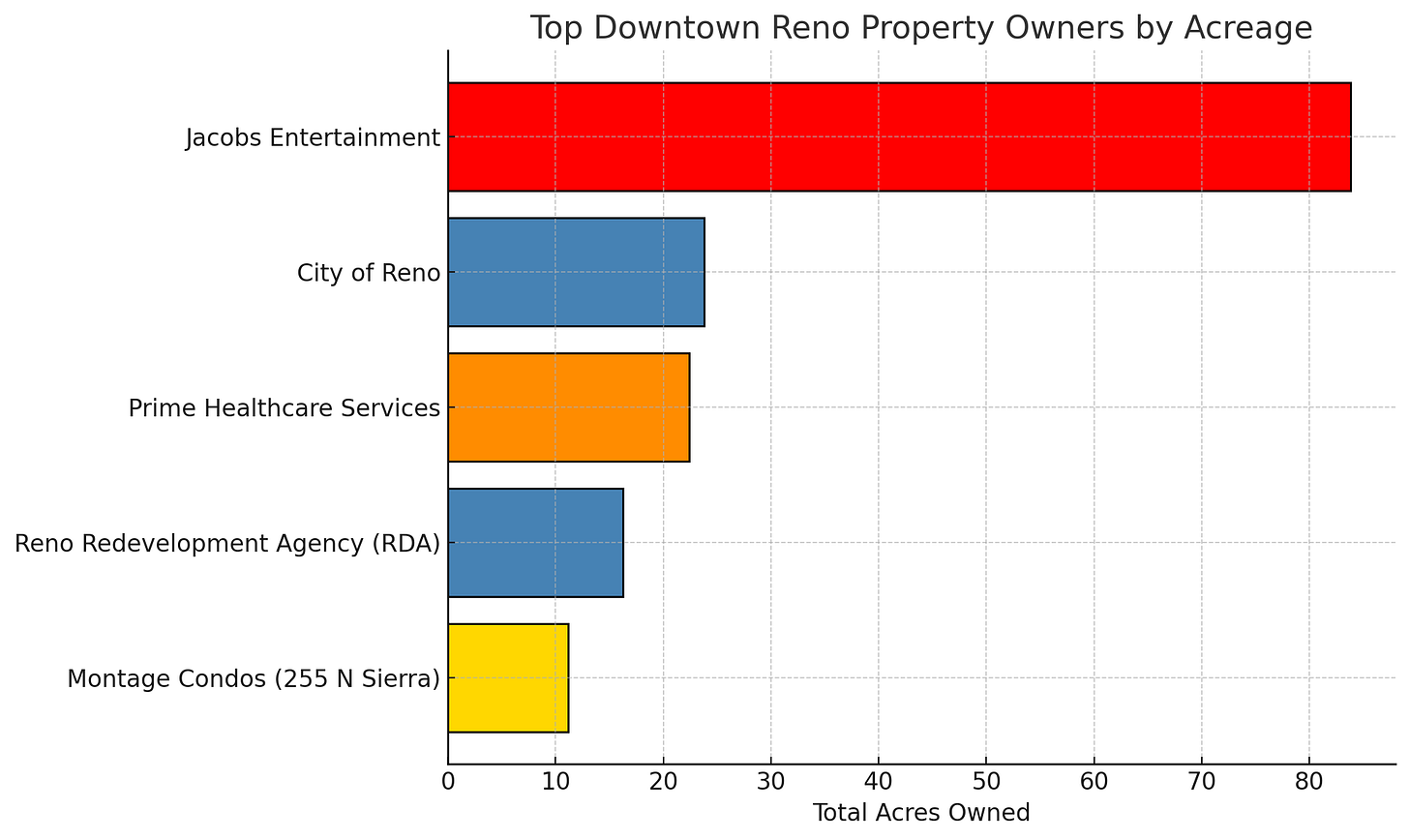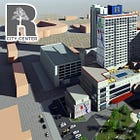🏙️ Let's Take a Look at Who Owns Downtown Reno by Acreage
In this report, I break down who owns downtown Reno, how that ownership is concentrated, and what it means for the City’s future.
The Quiet Power Behind the Parcels
When we discuss downtown Reno’s future, the conversation typically revolves around new development projects, city council decisions, and proposals from the planning department. But behind the scenes, the fundamental drivers of change are the landowners themselves. After all, control of land is control of opportunity.
🔢 The Big Picture: Who Owns What?
Using Washoe County Assessor records, I analyzed all land holdings within the downtown footprint. There are approximately 443 acres in total.
Owner - Parcels - Acres - % of Downtown
🟥 Jacobs Entertainment - 79 - 83.81- 18.9%
🟦 City of Reno - 27- 23.79 - 5.4%
🟧 Prime Healthcare Services - 17 - 22.41 - 5.1%
🟦 Reno Redevelopment Agency (RDA) - 15- 16.27- 3.7%
🟨 Montage Condos (255 N Sierra) - 31- 11.16- 2.5%
⚪ Everyone Else (1,400+ owners) 1,406 - 308.46 - 64.4%
✅ Key Insight: Just five ownership groups control 35% of downtown Reno’s land.
🏗️ Jacobs Entertainment: The Dominant Force
Jacobs Entertainment has quietly become the largest private landholder in downtown Reno. Through LLCs, often with mailing addresses in Florida or Colorado, Jacobs has acquired nearly 84 acres across more than 80 parcels, particularly in the West 4th Street corridor.
Some of the LLCs used include:
Reno Real Estate Development LLC
0W Commercial Row LLC
260 West 4th Street LLC
CTO16 Reno LLC
Through these entities, Jacobs owns the J Resort, Gold Dust West, The Gold and Silver Inn, 245 Arlington apartments, motels, and many other properties.
Many of these properties are currently vacant, used for parking, or held for future development under the Neon Line District concept. This land banking strategy gives Jacobs the power to accelerate or stall growth, depending on its timeline.
🏛️ Public Ownership: City vs. RDA
The City of Reno owns 23.79 acres, essentially civic facilities and parks.
The Reno Redevelopment Agency (RDA) owns another 16.27 acres. While often confused with the City, the RDA operates independently and is tasked with facilitating private-sector revitalization.
Notable RDA-owned properties include:
The Reno Ballroom
Reno Events Center
National Bowling Stadium
This makes the RDA a key player in shaping development outcomes, particularly in areas such as public-private partnerships, incentive packages, and land transfers.
🏢 Montage Condos: Individual Ownership
The Montage, a condominium complex located at 255 N Sierra Street, comprising 31 parcels and over 11 acres, represents a significant portion of individually held residential property in the downtown core.
🧩 The Fragmented Majority
After the top 5 property holders, more than 1,400 individual owners hold the remaining 57.5% of downtown land. Most own a single parcel and control less than half an acre.
🛣️ Virginia Street: The Heart of Downtown Reno
Beyond the casinos and large landholders, Virginia Street is shaped by its small property owners—a diverse group of about 30 different owners who collectively hold approximately 40 smaller parcels. These modestly sized lots are often home to retail storefronts, restaurants, salons, and boutique offices that contribute to the street’s vibrancy and identity. Yet, their size also presents unique challenges: limited space for expansion, higher per-square-foot renovation costs, and vulnerability to speculative buyouts. The most common land uses on the corridor are:
🃏 Casinos
🛍️ Retail Stores
🏬 Reno Revival formerly Harrah’s
🏢 Office Buildings
As Reno reimagines its Downtown, Virginia Street is both the anchor and the opportunity. Its fragmented ownership provides variety, but also demands coordination if the City wants to see cohesive, walkable, and vibrant redevelopment.
Many owners are holding on to their properties, apparently waiting for tenants who will pay higher rents or a potential big sale price. This elevated vacancy reflects the challenge of activating storefronts in a fragmented and aging downtown environment. It underscores the need for revitalization efforts that focus not just on entertainment anchors but also on supporting small landlords and local businesses.
🎰 Harrah’s to Reno Revival
In 2020, the Harrah’s casino was sold and rebranded as Reno City Center, and later as Reno Revival, a developer-backed entity located along Virginia Street. The sale was pitched as a transformative move, turning an aging casino into a live-work hub featuring modern apartments, tech offices, retail, and dining. Progress has been slow and troubled. See my article about Harrah’s,
Fragmented Ownership Means:
✅ Diverse land uses and small business presence
❌ Slow coordination on large-scale redevelopment
This also means that speculators, family trusts, and legacy owners play an often overlooked but pivotal role in what gets built or doesn’t.
💡 Why It Matters
Land ownership is power. City planning can propose. Citizens can demand. But nothing happens until the landowners agree. These players will shape downtown more than any mural, master plan, or campaign promise.
See my article on the need for a blight tax:
🔚 The Bottom Line: Who Owns the Future?
As downtown Reno stands at a crossroads, the question isn’t just what we want the city to become—it’s who holds the power to shape it.
Behind every stalled storefront or gleaming high-rise rendering is a deed, an LLC, a land strategy.
Whether it’s Jacobs Entertainment land banking half a district, the City of Reno weighing civic priorities, or condo owners at The Montage defending their lifestyle, the map of Reno’s future isn’t in planning documents—it’s in property records.
✅ If we want a downtown that reflects the public good, not just private portfolios, we must start by knowing who owns what—and holding them accountable for what comes next.






The idea of imposing a blight or vacancy tax, as you mentioned in the linked article of yours from June 7, is a good one. We know most Council members are beholden and subservient to the big downtown landowners who foot their campaigns, but perhaps raising the possibility of this tax during a debate during the next election would be enlightening. That implies, of course, that there of some folks willing to challenge the good-ol-boy, established network of cronies currently milking the system.